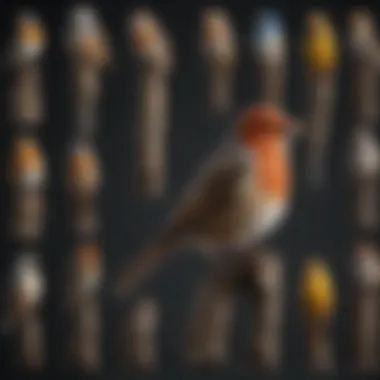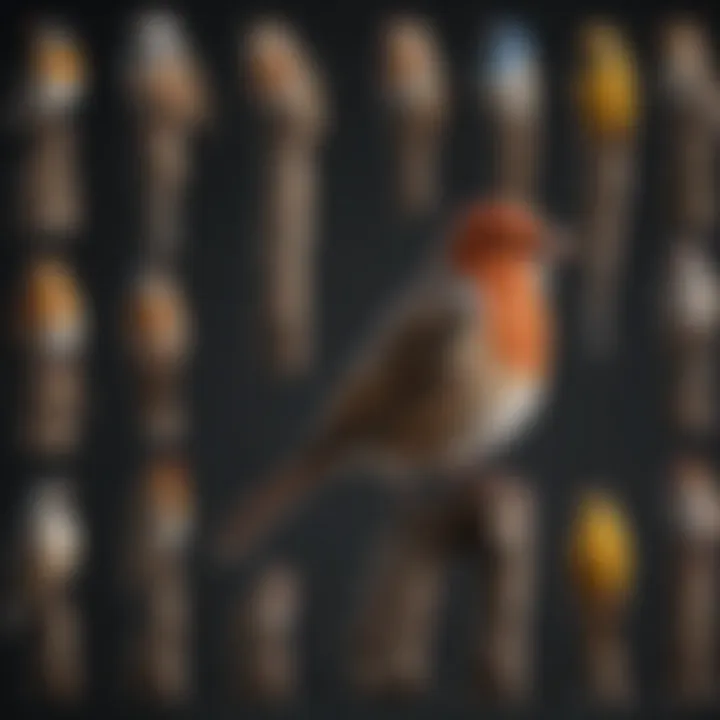Decoding Bird Sounds: Mastering Avian Communication


Intro
Understanding the sounds of birds is a vital skill for pet bird owners, aspiring bird parents, and breeders. Birds communicate through a wide range of noises, each serving a purpose. Recognizing these sounds enhances interaction and helps foster a deeper bond with birds. This guide will immerse you in the world of bird noises, detailing the types and significance of various sounds.
Care Tips
Daily Care Routines
Each day involves principles and practices crucial for maintaining a healthy environment for birds. Daily routines help monitor behavior, diet, and overall well-being while providing opportunities for interaction. Observing sounds made during daily routines —soft chirps during feeding or excited calls during playtime— can be indicators of their emotional states.
Cage Setup and Maintenance
An adequately setup cage contributes to a bird’s well-being directly affecting the normal sounds they engage in. Ensuring the cage is spacious enough for movement is essential to support physical and psychological health. Cage maintenance includes regular cleaning and providing essential items that promote natural behaviors.
Hygiene and Cleaning Practices
Maintain a clean environment. This includes regular cage cleaning, checking for soiled materials, and ensuring fresh water is provided daily. A clean space reduces the risk of illness and improves the quality of life of your bird, often leading to behavior characterized by more social and vibrant sounds.
Seasonal Care Adjustments
Changing seasons might necessitate different care routines. In winter, for example, it is vital to consider heat sources and maintain drinking water comfortably warm. During warmer months, providing adequate shade and fresh air is critical. Sounds these adjustments evoke can reflect your bird's comfort level and likely readiness for seasonal changes.
Behavioral Insights
Bird behavior is complex, demonstrating various moods and emotions. Below are ways to interpret behavioral cues, including communication through sound.
Understanding Bird Body Language
Birds often accompany their sounds with physical cues. Understanding their body language helps interpret the situations leading to certain sounds or noises. For instance, puffed feathers and loud calls could indicate surprise or a need for space, while soft noises might reflect contentment.
Common Behavioral Issues and Solutions
Some common behavioral issues include aggressive behavior or excessive vocalization. Addressing such issues often involves understanding the reasons behind specific sounds, allowing a considerate response. Solutions may include behavioral enrichment, and technique practices to correct undesirable sounds.
Positive Reinforcement Techniques
Positive reinforcement can lead to more desirable sounds and behaviors. Reward your bird with treats or attention whenever they produce a pleasant sound. This method fosters a willingness to engage in interactive communication over time.
Social Interaction Needs
Birds thrive on interaction, with social birds often expressing more complex sounds. Identify ways of engaging them based on their preferences and natural inclinations to vocalize these sounds. Loneliness might lead to unwanted noises as your bird seeks interaction, meaning that understanding their sounds is critical for social needs.
Nutrition Guides
A well-balanced diet contributes to a bird's overall health and can affect their vocal abilities. Understanding their nutritional needs is essential to fostering a vibrant and active pet.
Essential Diet Components
It’s vital to know what constitutes a healthy avian diet. Generally, seeds, pellets, and fresh fruits provide a balance of nutrients. Each bird species has dietary requirements, which should be studied closely.
Safe and Toxic Foods
All foods for birds are not created equally. Grains and certain grains might be nutritious, while others are poisonous. It’s crucial to do research or consult with a vet before introducing new items.
Supplements and Treats
Add variety to their diet with safe treats. Many treats act as valuable supplements offering essential nutrients. The occasional introduction of these not only diversifies their experience with food but also keeps them vocal and engaging during meal times.
Feeding Strategies for Different Species
Vary feeding activities to accommodate differences among bird species. Understanding how your species feeds and adjusting feed frequency reflect also on their sounds. For social meal times, consider implementing a feeding schedule allowing normal sounds, welcoming communication between pets.
Wellness and Health
Ensuring well-maintained health through routine care lays the foundation for timely communication through sounds.
Routine Health Checkups
Frequent veterinary checkups help ensure that your bird remains in good shape. Sounds, in this context, can serve as cues for health concerns. For instance, changes in the tone or frequency could possibly indicate illness or stress that need to be examined.
Identifying Symptoms of Illness
Understanding how sounds shift during illness helps detect health issues early. Changes such as wheezing or hooting more often should warrant immediate attention. You should observe how changes of sounds connect to shifts in behavior.
Preventative Care and Vaccinations
Keep preventive measures in mind while ensuring scheduled vaccinations per indicated species. This discipline can impact your bird’s overall attitudes and vocalizations positively, promoting a sound lifestyle.


Mental and Emotional Well-being
Stimulation leads to happier, vocal birds. Engaging toys comfort them. A mentally stimulated bird often expresses more diverse vocalizations reflecting emotional satisfaction. Integrating new experiences promotes a sharp, healthy vocal presence.
Enriching Activities
Engaging birds in diverse activities creates opportunities for sounds that reflect excitement and comfort.
Toys and Playtime Ideas
Provide toys that wed creativity and movement, allowing exploration. Integrating elements like swings offers opportunities for play as well as sounds when enjoying their environment.
Training and Tricks
Training offers mental challenges. It fosters verbal and nonverbal communications. Teaching basic tricks can lead to better bonding and increased many types of vocal energies from your bird over time.
Outdoor Activities and Interaction
Adding outdoor time allows birds to discover new sounds. They can also interact meaningfully with different environments; exploring these experiences induces natural reactions or vocalizations.
DIY Projects for Mental Stimulation
Building enrichment projects enables sharing of experiences between you and your bird. Use materials that allow experimentation at home, motivating curiosity leading to social vocalizations. Lively interactions create a vibrant household that resonates with sounds.
Understanding and decoding bird sounds significantly enlightens us and enriches our avian companions’ lives.
Intro to Bird Noise Identification
Bird noise identification is a crucial skill for anyone interested in avian life. Understanding bird sounds can enhance one’s connection to these creatures and contribute to the caretaker experience. As many bird owners know, their pets communicate through a variety of sounds. Being able to identify these sounds is essential for interpreting moods, needs, and even health issues.
Recognizing bird sounds extends beyond mere auditory appreciation. It allows pet owners to create a deeper bond with their birds. Birds convey a range of emotions through their calls. Identifying distinct sounds can aid in understanding stress or displaying contentment. Therefore, recognizing these sounds enriches interactions between birds and their owners.
Additionally, being familiar with bird communication can help in managing various challenges that arise in care. For instance, knowing an alarm call can prompt prompt making necessary changes in the environment to minimize stress. It is crucial as bird enthusiasts often overlook subtleties in sounds, which can signify important messages.
Moreover, understanding the implications of bird sounds can even extend to screening the bird’s health. For instance, changes in vocalizations, licking or scratching noises, can hint at underlying health issues. Recognizing these sounds serves as an early warning system, enabling caretakers to address potential problems proactively.
In essence, diving right into bird noise identification empowers owners to not only appreciate avian communications but also respond effectively to their recreational contentment and overall well-being. Developing this skill will afford you the tools for better companionship with your pet birds while broadening your insights into avian behavior and ecology.
Bird communication is complex yet invaluable—it is a bridge to understanding our feathered friends.
Understanding Bird Communication
Bird communication plays a critical role in the lives of birds. Understanding these sounds is essential for birdkeeping enthusiasts. The variety and complexity of bird chirps, calls, and songs reveal much about their behavior, social structure, and environment. For bird owners, recognizing and interpreting these noises provides invaluable insights into their pets’ well-being.
A primary purpose of bird sounds is to convey information. Through vocalizations, birds express various needs and emotions. Learning these sounds can enhance interactions between owners and their birds. Monitoring changes in vocalizations can also serve as an early indicator of health issues.
The Purpose of Bird Sounds
Bird sounds serve several key purposes in avian life. They are not just for aesthetic enjoyment; rather, these sounds fulfill fundamental ecological and social functions. Understanding these purposes can offer meaningful insights into the lives of birds.
- Attraction: Many birds use songs to attract mates. During the mating season, males often engage in elaborate singing to showcase fitness and genetic quality.
- Territoriality: Birds frequently establish their territories through calls. A loud proclamation of a specific sound warns others to stay away from an established area.
- Alarm Signals: Birds also produce sounds to alert others of predators. Recognizing these alarm calls can be crucial for survival within the avian community.
Types of Calls and Songs
Bird vocalizations can be categorized into distinct types. Understanding these specific categories enriches one’s interaction and observation of birds.
Songs as Mating Calls
Songs, primarily produced by male birds, are often regarded as mating calls. They are complex in structure and serve the purpose of attracting potential mates. A key characteristic of songs is their melodious nature, distinct from other bird sounds.
Bird owners especially appreciate this aspect. Mating songs demonstrate not only the bird's health but also its desire to breed. The unique feature of these songs is their variation across species, which affords enchantment and character.
However, the reliance on songs can have disadvantages. Operators need to discern these from other constant noises in or around homes, especially in an urban setting.
Alarm Calls
Alarm calls differ significantly from mating songs as they convey urgent warnings. These calls alert other birds, and sometimes their owners, to potential threats like predators. Notably, alarm calls are typically short and abrupt, in stark contrast to melodic songs.
Their utility in indicating danger makes them indispensable within bird communities. Listeners should prioritize learning these calls. The challenge lies in their variation; different species often have distinct alarm calls that may require familiarity to recognize effectively.
Contact Calls
Contact calls create a constant communication line among birds. These sounds facilitate social interactions, helping flocks maintain contact during movement. Characteristically, contact calls are generally soft, simple, and repetitive.
For bird owners, understanding contact calls can foster more affectionate relationships with their pets. Listening for these calls can reveal their social needs or emotional states. The drawback, however, is that they can be subtle and often overlooked amidst louder sounds of an environment.
In summary, the intricacies of bird sounds provide useful avenues for enhancing the bond between owners and birds. Understanding these vocalizations allows for deeper observation and interpretation of their behavior.


Methods of Bird Noise Identification
Identifying bird sounds is not just a hobby but also a skill essential for enthusiasts. Bird noise identification allows individuals to adore their avian pets while understanding their emotions and needs. Employing sound recognition techniques, leveraging field guides, and honing observational skills form the core methods for effective bird noise identification. These methods offer both the benefit of improved communication and deeper connections with birds.
Sound Recognition Techniques
Sound recognition is a foundation of bird noise identification techniques. Many birds have sophisticated systems of vocalization, creating a wide array of sounds. Recognizing these sounds can enhance interactions. First, focus on tonal qualities and pitches—the characteristics tell you important things. For example, high-pitched calls may indicate excitement, while deeper notes might suggest caution or alertness.
Practicing in the field assists in this learning process. Repetitive listening to local bird songs strengthens brain capability in identifying patterns and variations. You can use digital recordings to aid memory retention. Observing the behavior associated with certain sounds adds another dimension to the learning process.
Using Field Guides and Resources
Varied resources exist to assist people interested in bird noise identification. Field guides hold historical significance and extensive knowledge and are helpful. Two critical categories in this segment are Books on Bird Sounds and Online Databases.
Books on Bird Sounds
Books on Bird Sounds offer a comprehensive overview of both visual guides and auditory guidance. One key characteristic of these books is their sound maps and accompanying CDs or downloadable content. This multi-modal approach makes sound identification practice more effective.
One of the beneficial aspects is that these resources are often tailored to specific geographical areas. Readers often appreciate the localized content as it resonates personally and helps in context caching. However, there are a few disadvantages. For example, books may become quickly outdated because of the rapid advancement in bird research.
Online Databases
Online Databases serve as vital tools for contemporary bird sound classification. Various platforms enable users to listen to countless recorded bird sounds seamlessly. A prominent feature of these databases is their accessibility. Anyone can obtain information from any remote area with just an internet connection. This opens avenues for broader reach and learning.
Their databases allow for direct comparison between different species' sounds unique uploads. However, noise quality varies widely across recordings. This variability can sometimes be problematic. Poor quality recordings cause frustration, especially when trying to learn an exact call or song.
Observational Skills
Natural observational skills provide a fundamental angle in understanding bird communication. Participants must engage in their environment fully and actively, observing call instances triggering with behaviors.
Focusing on visual cues adds another layer. Birds often correlate their vocalizations with specific actions. Note patterns like body language or seasonal changes correlating with sound dynamics. Understanding contexts in which particular sounds are used further enhances identification competence.
In summary, identifying bird sounds requires deliberate practice and the strategic use of available tools. Implementing sound recognition techniques, utilizing field guides, and developing keen observational skills can significantly improve your abilities to decode avian communication.
Technological Advances in Bird Sound Identification
Technological advancements have significantly enhanced the process of bird noise identification, introducing innovative tools and methodologies that aid both amateur bird watchers and professional ornithologists. In an age where technology plays a pivotal role in various fields, bird sound identification has also elevated its efficacy through applications and dedicated hardware that assist users in analyzing and recognizing avian vocalizations.
These advancements facilitate an informed understanding of the diverse sounds that birds produce. They also offer a broader scope for research and educational purposes. Effective utilization of these tools not only streamlines the bird-identifying process, but they also deepen the user's connection to avian life and enrich their bird-watching experience. Thus, embracing these technologies is essential for enhancing one’s skills in identifying bird sounds accurately.
Mobile Applications for Bird Sounds
Mobile applications designed for bird sound identification appear as convenient tools for enthusiasts determined to improve their skills. These apps typically encompass a range of features, allowing users to access sound libraries of various bird calls and songs swiftly. Applications such as Merlin Bird ID and BirdNET utilize advanced algorithms and machine learning methods to propose potential bird matches based on sounds recorded through devices.
The interactive platforms invite users to record sounds and receive feedback almost instantaneously. This aids in recognizing individual birds and improves identification skills. The advantage of these mobile apps lies in their portability, giving bird watchers easy access to vast databases of bird sounds while they are in the field or at home.
However, several considerations exist. Battery life can quickly diminish, impacting usability during extended outdoor sessions. Moreover, the accuracy of app suggestions remains heavily reliant on the quality of sound recordings and local bird populations. Nonetheless, the advantages usually outweigh the downsides, thus making mobile applications a cornerstone for modern bird sound identification purposes.
Audio Recording and Analysis Tools
In conjunction with mobile applications, audio recording and analysis tools are tailored for individuals or researchers embarking on serious studies of bird sounds. Devices such as marantz PMD-661 and Tascam DR-05 fulfill professional standards, providing precise sound capture in various environments.
These high-quality recorders come equipped with necessary filters to minimize ambient noise. After recording, analysis software within the digital audio realm allows researchers to visualize the frequency and patterns of bird sounds with precision. This data is instrumental for understanding not just the types of calls, but also their frequency, duration, and other contours that might reflect behavioral patterns.
Key benefits of these tools include:
- Enhanced sound quality for effective identification.
- Detailed data and visual representation for analyzing vocal patterns.
- Logical archiving of recordings for research references.
One must bear in mind the required learning curve for these tools—familiarity with software and audio recording techniques can take some time. Additionally, equipment and software can require a significant investment. However, the depth of data and insights gained through this technology often justify the initial costs.
The Ecological Significance of Bird Sounds
Bird sounds play a crucial role in understanding the ecological systems where avian species thrive. These sounds are not merely a backdrop of nature; they hold significant meaning in relation to the survival and wellbeing of birds. In this section, we will explore the importance of bird sounds within ecosystems, discussing aspects such as communication, mating, and territorial defense.
Bird sounds and their Role in Ecosystems
Bird vocalizations serve various functions essential to environmental interaction. They help transmit information vital to the survival of individual birds and their species. For example:
- Mating calls signal reproductive availability, enabling birds to attract potential mates. These calls exhibit different characteristics based on species, often varying in pitch and frequency.
- Alarm calls warn others about predators or disturbances in the vicinity. The ability to communicate the presence of danger swiftly can determine survival outcomes for both individuals and flocks.
- Territorial calls are instrumental in minimizing conflicts with other birds by asserting dominance and marking boundaries, thus reducing physical confrontations. Birds use these sounds to establish their presence in an area, ensuring mates and resources are preserved.
These examples show that bird sounds are a vital form of communication that helps maintain the balance of ecosystems. They not only affect bird behavior but also play a part in the human enjoyment of nature. Residents in urban areas, for example, benefit from ties to wildlife through these sounds. Understanding their ecological role can foster appreciation and efforts in conservation work.
Impact of Urbanization on Bird Communication
Urbanization significantly affects bird communication patterns as cities rearrange natural habitats and alter soundscapes. Changes in their environment can disrupt established communication networks among birds. There are several ways urban landscapes impact bird vocalizations:
- Noise Pollution: Increased production of sounds in urban areas can mask bird calls. Reduction in sound clarity and range occurs, making it challenging for individuals to communicate effectively.
- Altered Habitat: Urban landscapes often replace natural vegetation with buildings and roads, dramatically changing the noises constantly surrounding birds. The structures disconnect previously connected habitats, which diminishes opportunities for interaction.
- Adaptation: Some bird species adapt to urban noise by modifying their calls. This can mean singing at higher frequencies to stand out. However, these adaptations often come at a cost, influencing mating success and social structures.


Loss of acoustic information can have deleterious impacts not only on communication among birds but also on their resource allocation and breeding success. Conserving natural habitat and maintaining sound environments might become crucial in ensuring that birdlife can coexist with urban development.
Understanding the ecological significance of bird sounds informs strategies to promote biodiversity. Recognizing how urbanization alters communication invites a dialogue on nature conservation within urban settings, benefiting both humans and avian species alike.
Ultimately, acknowledging the ecological contribution of bird sounds fosters a broader perspective regarding conservation and the intimate connections we share with these creatures. Advocates for avian preservation may leverage this knowledge in efforts aimed at fostering harmonious living conditions for both birds and humans.
Practical Applications of Bird Noise Identification
Understanding bird noises offers various practical applications that are relevant for pet bird owners and aspiring bird parents. The ability to identify and interpret sound can significantly enhance the experience of owning birds, providing insights into their needs and well-being.
Enhancing the Owner-Bird Relationship
Recognizing specific calls allows owners to respond effectively to their birds. For example, a chirp may indicate a wish for attention, while repetitive notes might signal anxiety or boredom. By understanding these sounds, owners can adjust their behavior accordingly, fostering a stronger bond. A close relationship based on clear communication can lead to happier and healthier birds.
Additionally, bird owners who take note of unique sounds may notice changes over time, reflecting sie changes in their environment or emotional state. Such observations can lead to prompt actions that improve the well-being of the pet.
Monitoring Bird Health Through Sounds
Birds communicate not only to express emotions but also to indicate health changes. An unusual sound can be an early warning sign of medical issues. Owners attuned to sound can contextualize these noises, potentially leading to earlier diagnoses by avian veterinarians. Familiarity with regular sounds can make it easier to identify abnormalities.
For instance, a raspy sound when breathing may indicate respiratory problems. Ensuring regular monitoring of these characteristic calls helps in effective health management.
Encouraging Enrichment Activities
Identification of bird sounds can inspire activities that enrich their lives. For instance, simulating calls by using recordings or training can stimulate natural behaviors. This approach makes the living environment more captivating for the bird.
Outdoor experiences that include attempts to replicate local calls can also spark curiosity. Engaging activities enhance cognitive skills while allowing birds to exercise instinctual behaviors. Bird owners can develop creative interactive play to mimic natural situations and sustain their birds’ mental stimulation.
Challenges in Bird Noise Identification
Understanding the challenges in bird noise identification is essential for enthusiasts and professionals alike. Accurately recognizing and interpreting bird sounds require not only a keen ear but also an awareness of the significant obstacles that can impede this process. This understanding is particularly crucial in enhancing the overall experience of connecting with and caring for pet birds, as well as contributing to broader avian research efforts. The challenges can be broadly categorized into environmental noise interference and variability in bird calls.
Environmental Noise Interference
Environmental noise interference is a prevalent challenge that can complicate bird sound identification. Urbanization has led to escalating levels of background noise, which disrupts the clarity of bird sounds. Traffic, construction, and recreational activities create a cacophony that masks the subtle calls of birds. In many instances, this overlap makes identification nearly impossible without sophisticated tools.
To deal with this issue, bird watchers and owners can alter their approach:
- Choose quieter locations during specific times of the day, such as early mornings or late evenings, when birds are most vocal.
- Limit the disturbances caused by electronic devices and machinery.
- Use noise-canceling equipment like the Audiometer Pro or Tascam DR-05, which help enhance recording quality amid background noise.
The ability to address environmental noise has wider implications. Not only can it improve personal experiences in birding, but it can also contribute to conservation efforts. Gaining insight into avian behaviors in quiet or less disrupted environments enables researchers to draw better connections about species health and survival.
Variability in Bird Calls
The second primary challenge is the variability in bird calls themselves. Birds exhibit regional dialects, and even individual variations can alter how a single species sounds. For instance, the White-throated Sparrow has multiple variations in its call depending on its geographical habitat. This can confuse even seasoned bird watchers when identifying the species.
Several strategies can mitigate this issue:
- Familiarize yourself with the typical calls of local species in various regions, allowing you to establish a reference point.
- Utilize technology, such as the Merlin Bird ID app or BirdNET, enabling listeners to compare calls across different dialects.
- Maintain an interest in the developmental aspect of bird calls, particularly for nestlings and juveniles who might produce calls inadequately mimicking adult sounds.
Addressing the variability in calls not only fosters better identification but also leads to richer interactions with birds. Knowledge of how calls can differ challenges owners and observers to study bird sounds more critically, enhancing their overall connection with the creatures.
“Identifying a bird by its song is not just about recognition; it’s about immersing oneself in the avian world.”
Future Directions in Bird Noise Research
Advancements in bird noise research have become essential as scientists and enthusiasts continue to explore how sound interacts with avian behavior. These advancements have profound implications, revealing the intricacies of communication within bird species and informing conservation strategies.
Emerging Technologies
Emerging technologies are reshaping how researchers and bird enthusiasts approach bird sound identification. Acoustic monitoring devices, such as automated recorders and sensors, play a significant role. These devices can capture a wide range of frequencies over long periods, providing extensive data for analysis.
Machine learning also appears as a forefront technology by enhancing the capacity to process sound recordings. Algorithms can learn to recognize distinct bird calls by analyzing features in the sound. This capability enables faster identification, offering accuracy that benefits both researchers and hobbyists.
Furthermore, apps like Merlin Bird ID are on the rise as user-friendly tools. They allow people to contribute to crowd-sourced data, making sound identification accessible. As technology evolves, we will likely see an increased fusion of sound processing techniques with ecological research, paving the way for a greater understanding of bird communications.
Conservation Efforts through Sound Monitoring
The connection between conservation efforts and sound monitoring is increasingly recognized. Sounds convey essential information about bird populations and their behaviors. By continuously monitoring these sounds, scientists gain insights into variation, shifts, or declines within bird populations, ultimately aiding conservation strategies.
Acoustic telemetry represents one such advancement, where bird movements and breeding behaviors can be assessed by monitoring the sounds they produce. This method is particularly crucial for identifying species at risk and for evaluating the success of various conservation approaches.
Furthermore, researchers can more effectively study how urbanization impacts bird communication through ongoing sound analysis. This includes understanding how noise pollution modifies bird calls, which can disrupt mating or territorial behaviors. Therefore, sound monitoring not only deepens our understanding of avian life but serves as a potent tool in collected how difficulties facing habitat loss can be addressed proactively.
"Understanding sound communication is essentialIn formulating effective conservation strategies for our avian population."
Epilogue
In summary, understanding bird noises is essential for anyone involved in avian care, whether as a pet bird owner, aspiring bird parent, or breeder. The intricacies of communication among bird species provide valuable insights into their behavior and health. By correctly identifying and interpreting sounds, fosters better relationships between birds and their human companions.
Through this article, readers have explored various aspects of bird sound identification, from methods to emerging technologies that aid in enhancing this skill. Recognizing specific calls and songs can lead to fostering emotional bonds and improving interactions. Bird sounds also serve as indicators of well-being and environmental changes, which is why developing an ear for their unique vocabulary is pivotal.
Important consideration to remember:
- Develop Natural Skills: Engage attentively in bird listening to refine sound identification abilities.
- Utilize Resources: Take advantage of the wide array of field guides, applications, and online databases somewhat essential for competent bird sound recognition.
- Adapt and Respond: Pay attention to how environmental factors may influence or interfere with bird calls; this helps in assessing true sounds better.















